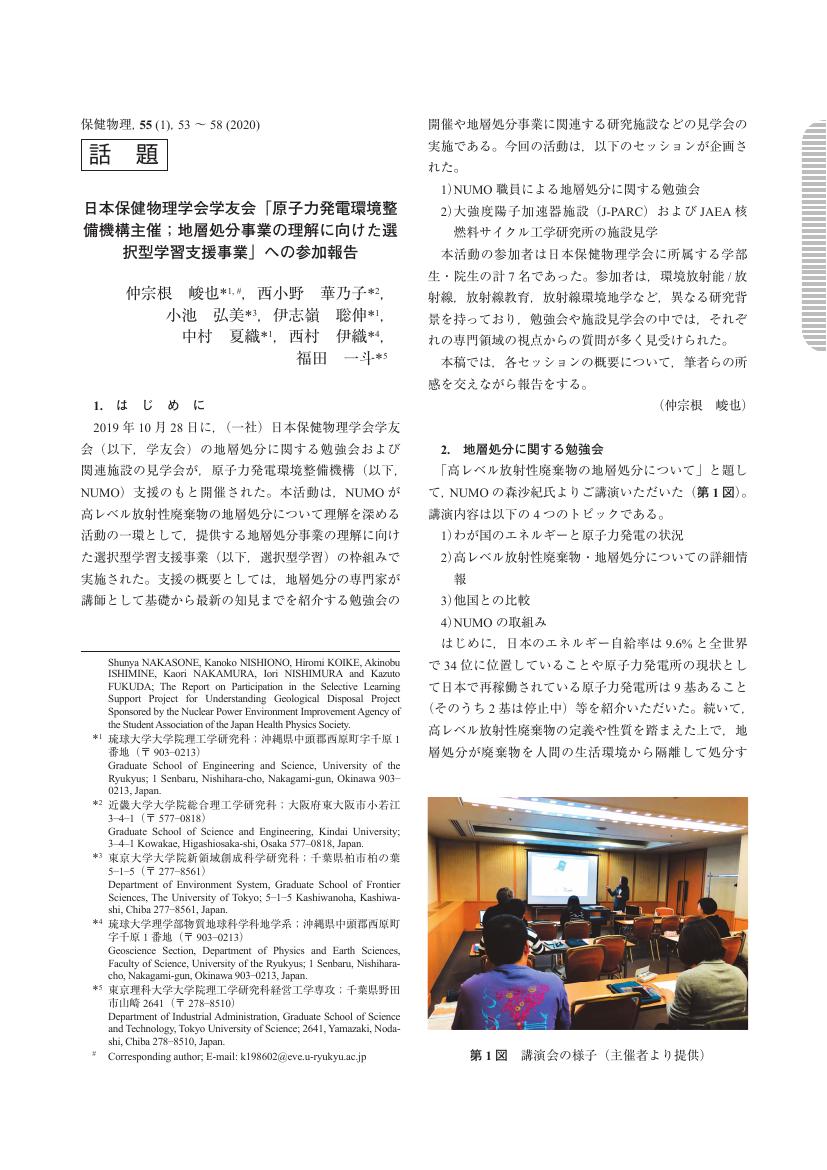1 0 0 0 日本保健物理学会第53回研究発表会印象記
1 0 0 0 OA 「第3回環境放射能・放射線研究会」参加印象記
- 著者
- 仲宗根 峻也
- 出版者
- 日本保健物理学会
- 雑誌
- 保健物理 (ISSN:03676110)
- 巻号頁・発行日
- vol.54, no.4, pp.231-233, 2019-12-27 (Released:2020-01-31)
1 0 0 0 OA 第5回環境放射能に関する国際会議(ENVIRA2019)への参加報告
1 0 0 0 「第3回環境放射能・放射線研究会」参加印象記
- 著者
- 仲宗根 峻也
- 出版者
- 日本保健物理学会
- 雑誌
- 保健物理 (ISSN:03676110)
- 巻号頁・発行日
- vol.54, no.4, pp.231-233, 2019
1 0 0 0 「日本保健物理学会第51回研究発表会」印象記
- 著者
- 仲宗根 峻也 城間 吉貴
- 出版者
- 日本保健物理学会
- 雑誌
- 保健物理 (ISSN:03676110)
- 巻号頁・発行日
- vol.53, no.3, pp.185-188, 2018
1 0 0 0 沖縄島における陸水中トリチウム濃度
- 著者
- 仲宗根 峻也 石津 裕二 池本 憲弘 城間 吉貴 赤田 尚史 田中 将裕 古川 雅英
- 出版者
- 日本保健物理学会
- 雑誌
- 保健物理 (ISSN:03676110)
- 巻号頁・発行日
- vol.53, no.2, pp.65-71, 2018
- 被引用文献数
- 1
In this study, to estimate the recent tritium concentration and its variation with latitude and time in Japan, environmental water samples were taken monthly from June 2014 to October 2016 in Okinawa Island, subtropical region of Japan. The inland water samples were taken from two springs and the drop water samples were taken in a limestone cave. The samples were distilled to remove impurities and then electrolysed using electrolytic enrichment system. Each of the enrichment samples was mixed with the liquid scintillation cocktail, and the tritium concentration was measured with a low background liquid scintillation counter. Arithmetic mean ± standard deviation for the tritium concentration of Morinokawa (spring water), Kakinohanahikawa (spring water) and Gyokusendo (cave drop water) samples were estimated to be 0.13 ± 0.04 Bq L<sup>-1</sup>, 0.12 ± 0.03 Bq L<sup>-1</sup> and 0.13 ± 0.03 Bq L<sup>-1</sup>, respectively. The comparison between these results and reported data suggested that the latitude effect is one of factors in the relatively low tritium concentration observed in Okinawa Island.


